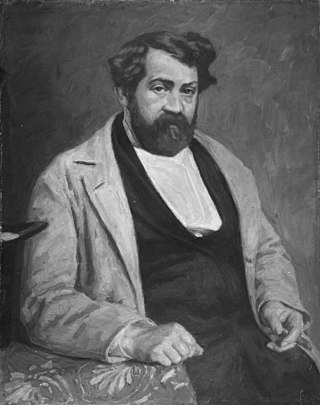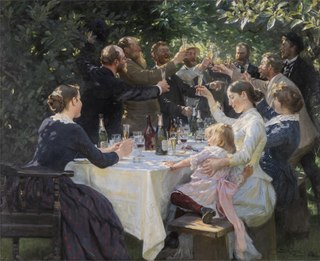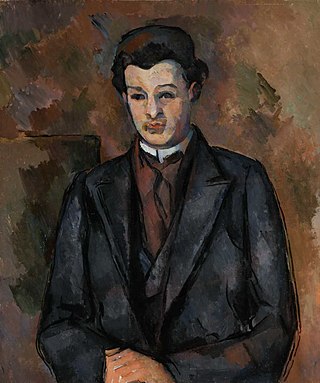
Peder Severin Krøyer, also known as P. S. Krøyer, was a Danish painter.

Johan Henrik Nebelong was a Danish architect. He worked in Norway from 1840 to 1853 and was best known for interior design work on Oscarshall (1847–1852). Nebelong also taught at the Royal Academy of Arts in Copenhagen.

Martinus Christian Wesseltoft Rørbye was a Danish painter, known both for genre works and landscapes. He was a central figure of the Golden Age of Danish painting during the first half of the 19th century.

Johan Christian Claussen Dahl, often known as J. C. Dahl or I. C. Dahl, was a Danish-Norwegian artist who is considered the first great romantic painter in Norway, the founder of the "golden age" of Norwegian painting. He is often described as "the father of Norwegian landscape painting" and is regarded as the first Norwegian painter to reach a level of artistic accomplishment comparable to that attained by the greatest European artists of his day. He was also the first to acquire genuine fame and cultural renown abroad. As one critic has put it, "J.C. Dahl occupies a central position in Norwegian artistic life of the first half of the 19th century.

Christian Skredsvig was a Norwegian painter and writer. He employed an artistic style reflecting naturalism. He is especially well known for his picturesque and lyrical depictions of the landscape.

Adolph Tidemand was a noted Norwegian romantic nationalism painter. Among his best known paintings are Haugianerne and Brudeferd i Hardanger, painted in collaboration with Hans Gude.

Erik Bodom was a Norwegian landscape painter.

Olaf Wilhelm Isaachsen was a Norwegian landscape and genre painter.

For much of its history Norwegian art is usually considered as part of the wider Nordic art of Scandinavia. It has, especially since about 1100 AD, been strongly influenced by wider trends in European art. After World War II, the influence of the United States strengthened substantially. Due to generous art subsidies, contemporary Norwegian art has a high production per capita.

Johan Fredrik Eckersberg was a Norwegian painter most noted for his landscapes. Eckersberg was a prominent figure in the transition from Romanticism to Realism in 19th-century Norwegian art, both as an artistic painter and a teacher at his own art school in Oslo.

The Skagen Painters were a group of Scandinavian artists who gathered in the village of Skagen, the northernmost part of Denmark, from the late 1870s until the turn of the century. Skagen was a summer destination whose scenic nature, local milieu and social community attracted northern artists to paint en plein air, emulating the French Impressionists—though members of the Skagen colony were also influenced by Realist movements such as the Barbizon school. They broke away from the rather rigid traditions of the Royal Danish Academy of Fine Arts and the Royal Swedish Academy of Arts, espousing the latest trends that they had learned in Paris. Among the group were Anna and Michael Ancher, Peder Severin Krøyer, Holger Drachmann, Karl Madsen, Laurits Tuxen, Marie Krøyer, Carl Locher, Viggo Johansen and Thorvald Niss from Denmark, Oscar Björck and Johan Krouthén from Sweden, and Christian Krohg and Eilif Peterssen from Norway. The group gathered together regularly at the Brøndums Hotel.

Ludvig Karsten was a Norwegian painter. He was a neo-impressionist influenced by Edvard Munch, Henri Matisse and contemporary French painting. He first participated at the Autumn exhibition in Kristiania in 1901, and had his first separate exhibition in 1904. He is represented at museums in many Scandinavian cities, including several paintings at the National Gallery of Norway. Karsten was known for his bohemian lifestyle and quick temper.

Hans Jørgen Hammer was a genre, landscape, and portrait painter and printmaker of the Golden Age of Danish painting. In addition, he served for eleven years as a military officer.

Mathias Stoltenberg was a Norwegian painter. He earned his living mostly as a travelling portrait painter and furniture restorer. His paintings were later rediscovered and presented at the 1914 Jubilee Exhibition in Kristiania.

Jacob Mathias Calmeyer was a Norwegian painter.

Jacob Wilhelm Nordan was a Danish-born, Norwegian architect. During his career, he was one of the most prolific church architects in Norway.

Joachim Christian Geelmuyden Gyldenkrantz Frich was a Norwegian landscape painter. He was associated with the Düsseldorf school of painting (Düsseldorf-skolen).

Louis Moe was a Norwegian painter, illustrator and writer who settled in Denmark.

Wilhelm Maximilian Carpelan was a Swedish military officer, draftsman, surveyor and cartographer. Together with Johannes Flintoe and Heinrich August Grosch, he was one of the first to survey and describe the interior of Norway; notably Telemark.

Harald Alfred Hauge (1876–1901) was a Norwegian painter who is remembered for his symbolist works. In 1894, he was one of ten artists who spent the summer months together in the collective known as Vågåsommeren. During his short life he travelled to Denmark, Belgium, France and Spain. Works by Hauge are in the collection of the National Museum of Norway.
























